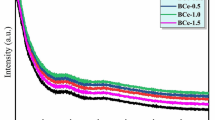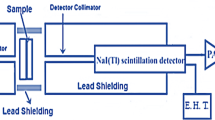The glass transition zone in the system PbCl2–PbF2–PbO–SiO2 was investigated; glasses, including those activated by neodymium, were obtained. The mechanical, optical, and spectral-luminescence properties of the glasses were investigated. It is shown that replacing fluorine with chlorine shifts the peaks of the luminescence and absorption lines to longer wavelengths.





Similar content being viewed by others
References
A. K. Przhevuskii and N. V. Nikonorov, Condensed Laser Media: Textbook, Course of Lectures [in Russian], SPbGU ITMO, St. Petersburg (2009).
S. Tanabe, “Spectroscopic studies on multiphonon processes in erbium doped fluoride and oxide glasses,” J. Non-Cryst. Solids, 256 – 257, 282 – 287 (1999).
E. Brown, U. Hömmerich, A. G. Bluiett, et al., “Synthesis and spectroscopic properties of neodymium doped lead chloride,” J. Appl. Phys., 101, 113103 (2007).
E1-Damrawi, “Influence of PbC12 on physical properties of lead chloroborate glasses,” J. Non-Cryst. Solids, 176, 91 – 97 (1994).
S. Sebastian and M. A. Khadar, “Optical properties of 60B2O3–(40 – x)PbO–xMCl2 and 50B2O3–(50 – x)PbO–xMCl2 (M = Pb, Cd) glasses,” Thiruvananthapuram, 27(2), 207 – 212 (2003).
B. M. Chabakauri, R. N. Kukharskii, and V. E. Kogan, “Influence of PbO on physical properties of lead chloroborate glasses,” Izv. Akad. Nauk Gruz. SSR, Ser. Khim., 11(3), 235 (1985).
I. A. Sokolov, I. V. Murin, N. A. Melnikova, and A. A. Pronkin, “Investigation of the ionic conductivity of glasses in the PbCl2–PbO ∙ B2O3 and PbCl2–2PbO ∙ B2O3 systems,” Glass Phys. Chem., 29(3), 411 – 420 (2003) [Fiz. Khim. Stekla, 29(3), 411 – 420 (2003)].
S. Sebastian and M. A. Khadar, “Microhardness indentation size effect studies in 60B2O3–(40 – x)PbO–xMCl2 and 50B2O3–(50 – x)PbO–xMCl2 (M = Pb, Cd) glasses,” J. Mater. Sci., 40(7), 1655 (2005).
J. Pisarska, R. Lisiecki, G. Dominiak-Dzik, et al., “Influence of PbX2 (X = F, Cl, Br) content and thermal treatment on structure and optical properties of lead borate glasses doped with rare earth ions,” Optica Applicata, 40(2), 351 – 358 (2010).
M. V. Kurushkin, A. V. Semencha, L. N. Blinov, and M. D. Mikhailov, “Lead-containing oxyhalide glasses,” Glass Phys. Chem., 40(4), 558 – 565 (2014) [Fiz. Khim. Stekla, 40(4), 558 – 565 (2014)].
A. A. Kiprianov and N. G. Karpukhina, “Oxyhalide silicate glasses,” Glass Phys. Chem., 32(1), 1 – 27 (2006) [Fiz. Khim. Stekla, 32(1), 3 – 40 (2006)].
S. A. Avanesov, M. I. Vatlina, B. V. Ignat’ev, et al., “Er3+ luminescence in lead-fluorine-chlorine-germanate glasses and glass-ceramics,” Ekolog. Vest. Nauch. Tsentrov ChES, No. 4, 5 – 13 (2009).
J. Tauc, R. Grigorovici, and A. Vancu, “Optical Properties and Electronic Structure of Amorphous Germanium,” Phys. Status Solidi, 15, 627 – 637 (1966).
L. A. Kosyachenko, V. M. Sklyarchuk, O. V. Sklyarchuk, and O. L. Maslyanchuk, “Band gap of CdTe and Cd0.9Zn0.1 Te crystals,” Semiconductors_Physics of the Solid State, 45(10), 1273 – 1280 (2011) [Fiz. Tekh. Poluprovodnikov, 45(10), 1323 – 1330 (2011)].
V. V. Sobolev, A. I. Kalugin, I. V. Vostrikov, and V. V. Sobolev, “Electronic structure and optical properties of lead chloride,” J. Surf. Invest., X-Ray, Synchrotron Neutron Tech., 3(1), 48 – 57 (2009).
V. G. Plekhanov, “Investigation of the reflectance spectra of PbCl2 and PbBr2 single crystals with orthorhombic structure,” Phys. Status Solidi (b), 68(1), K35 – K38 (1975).
V. A. Isaev, A. V. Skachedub, V. A. Klimenko, et al., “Intensity parameters of neodymium ions in crystalline strontium molybdate,” Polythematic Network of the Electronic Scientific Journal of the Kuban State Agrarian University, No. 91, 259 – 276 (2013).
M. N. Brekhovskikh, Yu. K. Voronko, L. N. Dmitruk, et al., “Synthesis and glass formation in the BaO–B2O3–BaCl2 system,” Inorg. Mater., 46(12), 1525 – 1530 (2010) [Neorg. Mater., 46(12), 1525 – 1530 (2010)].
Author information
Authors and Affiliations
Corresponding author
Additional information
Translated from Steklo i Keramika, No. 4, pp. 3 – 8, April, 2021.
Rights and permissions
About this article
Cite this article
Butenkov, D.A., Runina, K.I. & Petrova, O.B. Synthesis and Properties of Nd-Doped Chlorofluorosilicate Lead Glasses. Glass Ceram 78, 135–139 (2021). https://doi.org/10.1007/s10717-021-00363-3
Published:
Issue Date:
DOI: https://doi.org/10.1007/s10717-021-00363-3




